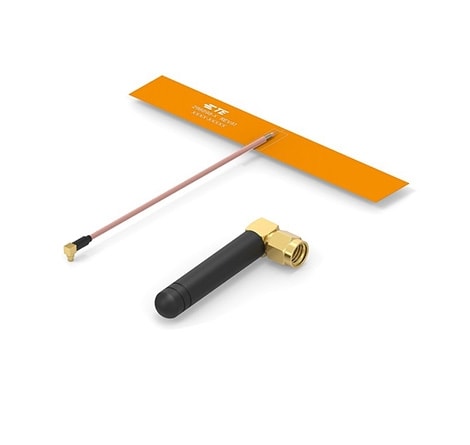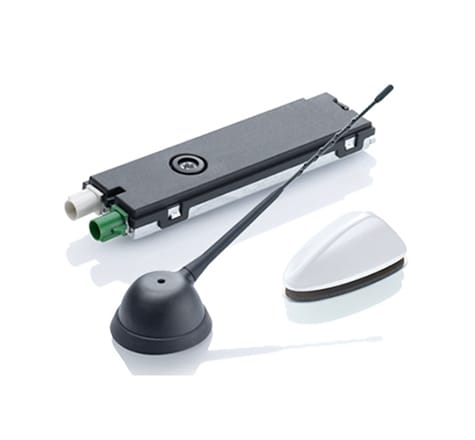
Robust functionality for today's networking needs
We offer a wide range of ISM antennas, LPWAN antennas, and LoRaWAN (LoRa) antennas, covering various frequency bands and mounting types, designed for different IoT devices. Our ISM antennas predominantly operable in the 433.92 MHz, 868 MHz, 915 MHz and 2.4 GHz center frequency bands. Our LPWAN antennas include a wide range of remote or terminal mounted antennas which offers a compact external antenna solution for IoT devices requiring more range. Our portfolio of LoRaWAN (LoRo) antennas includes remote- or terminal-mounted antennas and offers compact external-antenna solutions for IoT devices - also larger directional external antennas in the form of panel antennas or Yagi antennas for long range communications.
We manufacture a broad range of ISM antennas, LPWAN antennas, and LoRaWAN antennas. ISM antennas operate in industrial, scientific, and medical frequency bands. These do not require government licenses if used at 2.4GHz or lower which has
caused an explosion of usage for short range communication systems for wireless devices.
Our LPWAN antennas are designed to support Internet of Things (IoT) devices and networks at lower cost and with greater power efficiency than traditional wireless networks.
Our LoRaWAN antennas can cover vast distances, provide long battery life for IoT devices, and they offer a significantly larger communication range at low bandwidths compared to other wireless data transmission technologies.

ISM Antennas
Engineered to span a wide range of radio frequencies
Product overview: ISM antennas
ISM (Industrial, Scientific, and Medical) antennas operate in the ISM frequency bands, which span a wide range of radio frequencies (RF) that are a relatively narrow band. The antennas that fall under the ISM frequency bands can have very broad applications. Some antennas are designed for low-power, short-range transmissions, and in the same frequency bands there are long range directional antennas, such as Yagi antennas. ISM antennas can operate at much higher frequencies but require government licenses to do so. There is also a mix of licensed and unlicensed applications within many ISM frequency bands, and the bands permitted unlicensed access can also vary by region.
Because ISM antennas do not require government licenses if used at 2.4 GHz or lower, there has been an explosion of usage in recent decades for short range communication systems for wireless devices. This is sometimes called non-ISM use because the devices do not fall under industrial, scientific, or medical equipment. Wireless devices are now by far the largest usage of the ISM band. These devices include Wi-Fi networks, cordless phones wireless microphones, Bluetooth devices, garage door openers, baby monitors, wireless doorbells, keyless car entry systems, wild animal tracking, and near-field communication (NFC) devices such as contactless smart cards and proximity cards. When designing an IoT (Internet of Things) device or other wireless system, it is important to consider the differences between the sub-GHz band versus the 2.4 GHz band and how they can impact optimal system performance and commercial viability. The sub-GHz band typically allows a longer-range wireless communication link than the 2.4 GHz band and is more capable of penetrating objects like walls and buildings. Sub-GHz frequency waves are less susceptible to reflection, can bend further around obstacles, and often encounter less interference from the large amount of other wireless devices operating in the license-free bands. Sub-GHz networking is the preferred wireless technology in large building environments and is more frequently used in low bandwidth or low data rate applications; whereas, the 2.4 GHz band is used where a higher data rate is needed. Sub-GHz applications include fire alarms, hand-held payment devices, barcode scanners, smart meters, electronic point-of-sale, inventory tracking, remote process monitoring, and restaurant ordering systems.
TE Connectivity has a wide range of ISM antenna solutions, predominantly operable in the 433.92 MHz, 868 MHz, 915 MHz and 2.4 GHz center frequency bands. This includes embedded or internal antennas for short range communications; remote, dipole and terminal mount external antennas for mid-range communications; as well as outdoor rated external antennas for long-range communications.

LPWAN antennas
Low-cost solution for greater power efficiency
Product overview: LPWAN antennas
A LPWAN (low-power, wide-area network) allows long-range wireless communication at a low bit rate between low-bandwidth devices. LPWAN antennas are designed to support Internet of Things (IoT) devices and networks by operating at a lower cost and with greater power efficiency than traditional wireless networks. LPWAN antennas are also capable of supporting a larger number of devices over a larger area. Organizations that want to reduce the manufacturing and lifetime operating costs of IoT devices frequently choose LPWAN antennas as their communication method of choice.
LPWAN antennas enable numerous machine-to-machine (M2M) and IoT applications due to lower power requirements, longer ranges, and lower costs than traditional mobile networks. The tradeoff is that less data can be transmitted compared to other networks. LPWANs are therefore best suited for applications that need infrequent or downlink capacities or smaller data packets. LPWAN antennas are generally chosen to extend the battery life of smaller devices, and some batteries can be extended for as long as 10 years where infrequent data delivery from a remote location may be required. LPWAN antenna applications include smart metering, smart lighting, asset monitoring and tracking, smart cities, precision agriculture, livestock monitoring, energy management, manufacturing, industrial IoT devices and many more.
LPWANs can use a number of network technologies that are available in a variety of shapes and forms. LPWAN antennas can be used with licensed or unlicensed frequencies and there are proprietary or open standard options. One of the most widely used LPWANs is Sigfox, which is a proprietary and unlicensed public network that runs in the 868 MHz or 902 MHz band. Other LPWAN antenna applications include random phase multiple access (RPMA), which runs in the 2.4 GHz spectrum; LoRa, an unlicensed network that is less prone to interference because it transmits in several sub-GHz frequencies;as well as weightless SIG, narrowband-IoT (NB-IoT), and LTE-M. While NB-IoT and LTE-M are similar, they operate on existing cellular infrastructure, which allows service providers to add IoT connectivity quickly. NB-IoT, also called CAT-NB1, operates on existing LTE and Global System for Mobile (GSM) systems. LTE-M, also called CAT-M1, has the highest bandwidth of any LPWAN technology.
TE Connectivity has a wide range of LPWAN antenna solutions, starting from the smallest board mounted embedded or internal antennas designed for smaller IoT devices. A wide range of remote or terminal mounted antennas are available which offers a compact external antenna solution for IoT devices requiring more range.

LoRaWAN Antennas
Engineered to cover vast distances and for long battery life
Product overview: LoRaWAN antennas
LoRaWAN (Long-Range Wide Area Network) is a type of LPWAN technology that connects IoT devices using LoRaWAN antennas. LoRaWAN antennas can cover vast distances and help provide long battery life. LoRaWAN provides a significantly larger communication range at low bandwidths compared to other
wireless data transmission technologies. LoRaWAN allows bi-directional communication and offers excellent indoor penetration for IoT solutions, which has made it popular with smart city and industrial applications.
IoT sensors and devices that use LoRaWAN antennas consume very low power, which allows sensors to function for much longer. LoRaWAN can offer secure and reliable communication operating on a simple software architecture with the ability to handle thousands of devices or nodes. LoRaWAN is popular with developers, hardware vendors, IoT platforms, IoT technology vendors, system integrators, and telecom providers. In flat areas that have no obstruction, LoRaWAN antennas can communicate up to 30 kilometers, and in urban environments can reach around 3 kilometers depending on environment and obstructions. LoRaWAN can operate on many unlicensed radio frequencies around the world, including the popular 915 MHz band in the United States and 868 MHz band in Europe.
Because they use less bandwidth, LoRaWAN antennas can offer fast deployment, making them an optimal choice for IoT devices that have poor or inconsistent data transmissions. LoRaWAN antenna can offer a payload of up to 100 bytes, compared to just 12 bytes from Sigfox. There are no restrictions on the number of daily messages that can be sent with LoRaWAN, while Sigfox allows only 140 messages a day.
TE Connectivity has a wide range of LoRaWAN antenna solutions starting from the smallest board mounted embedded or internal antennas designed for smaller IoT devices. A wide range of remote or terminal mounted antennas are
available which offers a compact external antenna solution for IoT devices. Larger directional external antennas are also available in the form of panel antennas or Yagi antennas for long range communications.



